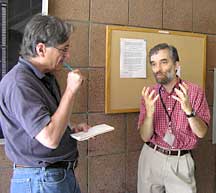Evidence on the wing: Cornell Lab of Ornithology director presents new proof that ivory-billed woodpecker exists
By Krishna Ramanujan

SANTA BARBARA, Calif. -- The director of Cornell's Lab of Ornithology, John Fitzpatrick, has presented new evidence that a grainy and blurry piece of videotape shows the ivory-billed woodpecker: His analysis indicates proof in the elusive bird's wing beats.
Presenting a plenary lecture at the American Ornithologists' Union Meeting at the University of California-Santa Barbara Aug. 25, Fitzpatrick said a new analysis of the video shows 11 wing beats of a retreating black-and-white-winged bird, consistent with the wing beats of an ivory-billed woodpecker and faster than the flight of the pileated woodpecker, commonly mistaken for the ivory-bill.
While skeptical ornithologists recently claimed that the video images, captured in the Big Woods of eastern Arkansas in 2004, likely show the smaller but similarly patterned pileated woodpecker, new studies indicate that the pileated woodpecker beats its wings between 7 to 7.5 times per second in a slow rowing motion.
By comparison, the bird in the video flies at a rate of 8.7 beats per second in a direct duck-like flight consistent with historical accounts of ivory-bills. Fitzpatrick played an April 1935 audio recording, made by the Lab of Ornithology's founder Arthur Allen, of an ivory-billed woodpecker in the Singer Tract in Louisiana flying away from its nest hole. The flapping wings are clearly audible. Using a spectogram showing audio patterns over time on a graph, Fitzpatrick showed that the 1935 ivory-bill had flapped its wings at 8.6 beats per second.

"My personal view is that I am convinced there are ivory-bills out there, one or more," Fitzpatrick said. "Absolutely convinced."
The blurry out-of-focus video of the ivory-bill, which had long been thought to be extinct, was taken accidentally by University of Arkansas associate professor David Luneau, who had his camera on auto-focus in his canoe while searching for the bird. The video images were the centerpiece of an April 28, 2005, online Science Express article, and was also analyzed in the June 3, 2005, issue of Science.
SANTA BARBARA, Calif. -- The director of Cornell University's Lab of Ornithology, John Fitzpatrick, has presented new evidence that a grainy and blurry piece of videotape shows the ivory-billed woodpecker: His analysis indicates proof in the elusive bird's wing beats.
Presenting a plenary lecture at the American Ornithologists' Union Meeting at the University of California-Santa Barbara Aug. 25, Fitzpatrick said a new analysis of the video shows 11 wing beats of a retreating black-and-white-winged bird, consistent with the wing beats of an ivory-billed woodpecker and faster than the flight of the pileated woodpecker, commonly mistaken for the ivory-bill.
While skeptical ornithologists recently claimed that the video images, captured in the Big Woods of eastern Arkansas in 2004, likely show the smaller but similarly patterned pileated woodpecker, new studies indicate that the pileated woodpecker beats its wings between 7 to 7.5 times per second in a slow rowing motion.
By comparison, the bird in the video flies at a rate of 8.7 beats per second in a direct duck-like flight consistent with historical accounts of ivory-bills. Fitzpatrick played an April 1935 audio recording, made by the Lab of Ornithology's founder Arthur Allen, of an ivory-billed woodpecker in the Singer Tract in Louisiana flying away from its nest hole. The flapping wings are clearly audible. Using a spectogram showing audio patterns over time on a graph, Fitzpatrick showed that the 1935 ivory-bill had flapped its wings at 8.6 beats per second.
"My personal view is that I am convinced there are ivory-bills out there, one or more," Fitzpatrick said. "Absolutely convinced."
The blurry out-of-focus video of the ivory-bill, which had long been thought to be extinct, was taken accidentally by University of Arkansas associate professor David Luneau, who had his camera on auto-focus in his canoe while searching for the bird. The video images were the centerpiece of an April 28, 2005, online Science Express article, and was also analyzed in the June 3, 2005, issue of Science.
Media Contact
Get Cornell news delivered right to your inbox.
Subscribe